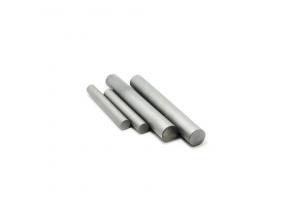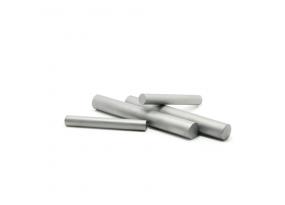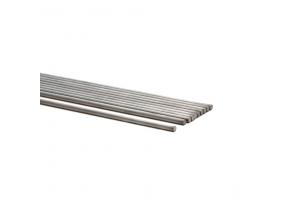An In-Depth Exploration of Tungsten-Copper (W-Cu) Alloys: Where Refractory Strength Meets High Conductivity
1. What is a Tungsten-Copper Alloy? Definition and Essence
From a metallurgical perspective, tungsten and copper are two immiscible metals, meaning they do not form a uniform solid solution or intermetallic compounds even at high temperatures. Consequently, W-Cu alloys are not produced through traditional melting and casting methods. In essence, they are a Metal Matrix Composite (MMC), also widely known as a "pseudo-alloy."
Its microstructure can be vividly described as a three-dimensional, porous skeleton formed by high-melting-point tungsten particles, with its pores filled and infiltrated by low-melting-point copper. This structure endows the material with a dual set of properties:
l Tungsten Skeleton: This forms the "bones" of the material, contributing its high melting point (tungsten melts at ~3422°C), high hardness, high strength, low coefficient of thermal expansion, and outstanding resistance to arc erosion.
l Copper Matrix: This acts as the "flesh," filling the gaps within the tungsten skeleton to form a continuous network for conducting electricity and heat, ensuring the material's excellent electrical and thermal conductivity.
By adjusting the volume or weight percentage of tungsten and copper, the final properties of the W-Cu alloy can be precisely "customized." This allows for an ideal balance between hardness and conductivity, or heat resistance and thermal dissipation, to meet the stringent requirements of diverse applications.
2. The Manufacturing Process: Forging a Union of Opposites
Due to the vast differences in the physical properties of tungsten and copper (e.g., melting point, density), their preparation is highly challenging and relies primarily on Powder Metallurgy (PM) techniques. The core process flow is as follows:
1. Powder Preparation and Mixing:
First, high-purity tungsten and copper powders are prepared. Then, according to a predetermined composition ratio (e.g., W70-Cu30 signifies 70% tungsten and 30% copper by weight), the two powders are uniformly blended in a mixer. The homogeneity of the mix directly impacts the consistency of the final material's properties.
2. Compacting/Pressing:
The blended powder is loaded into a die and subjected to high pressure, either through cold or warm pressing, to form a "green compact" with a specific shape and handling strength. At this stage, the compact is porous, and the particles are held together only by mechanical forces.
3. Sintering:
This is the most critical step. The green compact is placed in a sintering furnace with a reducing atmosphere (typically hydrogen, to prevent oxidation) and heated to a carefully controlled temperature—one that is above the melting point of copper (~1083°C) but well below the melting point of tungsten.
l At this temperature, the copper powder melts into a liquid phase.
l The liquid copper, driven by capillary action, rapidly fills the pores within the solid tungsten particle skeleton. This process is known as Liquid Phase Sintering.
l Simultaneously, the tungsten particles undergo a degree of solid-state sintering, making the skeleton denser and more robust.
4. Infiltration:
To achieve higher density and superior properties, an infiltration process is often employed. This method involves two steps:
l First, pure tungsten powder is pressed and pre-sintered to create a porous tungsten skeleton with a specific porosity.
l Next, this skeleton is heated together with a precise amount of copper above copper's melting point. The liquid copper automatically infiltrates and completely fills the pores of the tungsten skeleton.
Materials produced by infiltration typically achieve near-theoretical density, a more uniform microstructure, and enhanced performance.
5. Secondary Processing:
After sintering or infiltration, the W-Cu blank can be finished to final product dimensions and shapes using conventional machining methods such as turning, milling, drilling, and Electrical Discharge Machining (EDM).
3. Key Properties and Performance Characteristics
The appeal of W-Cu alloys lies in the synergistic effect of their properties, which is more than a simple average of the two constituent metals.
l Excellent Arc Erosion Resistance:
This is the most crucial advantage of W-Cu alloys. When exposed to a powerful electric arc, the high-melting-point tungsten phase resists melting and vaporization, maintaining the electrode's shape. Meanwhile, the copper phase vaporizes rapidly at high temperatures, absorbing a massive amount of heat (latent heat of vaporization). This creates a "transpiration cooling" effect that significantly protects the electrode material and extends its service life.
l High Electrical and Thermal Conductivity:
The continuous copper matrix provides a low-impedance path for the transport of electrons and heat. Although tungsten's conductivity is poor, copper's contribution allows the composite to achieve electrical and thermal conductivity far superior to pure tungsten, which can be increased by raising the copper content. This is vital for applications requiring rapid heat dissipation.
l High Hardness and Wear Resistance:
Tungsten is one of the hardest metals, and the skeleton it forms within the composite gives W-Cu alloys exceptional hardness and excellent resistance to wear and abrasion, making them perform well in applications involving mechanical wear.
l Low and Adjustable Coefficient of Thermal Expansion (CTE):
Tungsten has a very low CTE (approx. 4.5 ppm/°C), while copper's is much higher (approx. 17 ppm/°C). By adjusting the W-Cu ratio, the overall CTE of the composite can be precisely controlled. This allows it to be thermally matched with semiconductor materials (like Silicon, Si, or Gallium Arsenide, GaAs) or ceramic substrates (like Alumina, Al₂O₃, or Aluminum Nitride, AlN), preventing failure due to thermal mismatch stress.
l Good Mechanical Strength at Elevated Temperatures:
Because the tungsten skeleton retains its strength at high temperatures, the performance degradation of W-Cu alloys with increasing temperature is far less severe than that of pure copper or other conventional metals. This allows it to maintain structural integrity in high-temperature environments.
4. Common Grades and Property Differences
W-Cu alloy grades are typically named after their composition percentages. Different grades offer different performance priorities:
|
Grade |
Tungsten (W) % |
Copper (Cu) % |
Key Characteristics |
Typical Applications |
|
W50/Cu50 |
50 |
50 |
Best conductivity (electrical & thermal), lowest hardness. |
Primarily for heat sinks where maximum thermal dissipation is required. |
|
W60/Cu40 |
60 |
40 |
A good balance between thermal conductivity and hardness. |
High-performance heat spreaders, some resistance welding electrodes. |
|
W70/Cu30 |
70 |
30 |
One of the most common grades; a versatile mix of good arc resistance, conductivity, and hardness. |
High-voltage switch contacts, EDM electrodes, resistance welding electrodes. |
|
W75/Cu25 |
75 |
25 |
Enhanced hardness and arc resistance with a slight decrease in conductivity. |
High/ultra-high voltage circuit breakers, vacuum switch contacts, EDM electrodes requiring higher wear resistance. |
|
W80/Cu20 |
80 |
20 |
Excellent arc erosion and wear resistance; lower but still sufficient conductivity. |
Electrical contacts for severe-duty applications, plasma spray nozzles, certain specialty resistance welding electrodes. |
|
W90/Cu10 |
90 |
10 |
Extremely high hardness, density, and thermal shock resistance, primarily leveraging tungsten's properties. |
Rocket nozzle throat liners, armor-piercing cores (less common), components requiring ultimate high-temperature and erosion resistance. |

5. Core Application Areas
Thanks to its unique combination of properties, W-Cu alloys play a critical role in several high-tech sectors:
1. Power and Electrical Engineering:
l High-Voltage Electrical Contacts: In high and ultra-high voltage circuit breakers, disconnectors, and vacuum switches, the contacts generate intense arcs when interrupting large currents. W-Cu alloys effectively resist this arc erosion while rapidly conducting away heat, ensuring the reliability and long life of the switchgear.
l Resistance Welding Electrodes: Used in spot or seam welding. The electrodes require sufficient hardness to resist deformation under pressure, excellent conductivity to pass large currents, and non-stick properties, especially when welding non-ferrous metals or coated sheets. W-Cu is an ideal electrode material for these tasks.
2. Electronic Packaging and Thermal Management:
l Heat Sinks and Heat Spreaders: For high-power devices like CPUs, IGBT modules, high-power LEDs, and RF power amplifiers, the immense heat generated must be dissipated efficiently. With its high thermal conductivity and matching low CTE, W-Cu serves as an ideal substrate and heat sink material, preventing chips from overheating and failing.
3. Molds and Machining:
l Electrical Discharge Machining (EDM) Electrodes: EDM uses pulsed electrical discharges between an electrode and a workpiece to erode metal. W-Cu electrodes have a very low wear rate, allowing them to maintain fine details and thus machine high-precision molds and complex parts, especially for materials like tungsten carbide and hardened steel.
4. Aerospace and Defense:
l Rocket Engine Nozzle Throat Liners: In solid or liquid rocket engines, the nozzle throat endures extreme temperatures, high pressures, and high-velocity gas erosion. W-Cu alloys (especially high-tungsten grades) are used as throat liner materials due to their high-temperature strength, ablation resistance, and transpiration cooling effect.
l Other Applications: Also used in components requiring high density and high-temperature stability, such as the leading edges of missile fins.
5. Advantages, Disadvantages, and Future Outlook
Advantages:
l Unique Property Combination: Perfectly merges high-temperature and arc resistance with high electrical and thermal conductivity.
l Designable Performance: Properties can be tailored by adjusting the composition ratio.
l Excellent Performance in Extreme Conditions: A key material for solving challenges related to arc erosion and high-power thermal management.
Disadvantages:
l High Cost: Tungsten and copper are valuable metals, and the complex powder metallurgy process leads to high production costs.
l High Density: Tungsten's high density makes W-Cu alloys very heavy, limiting their use in applications where light weight is critical.
l Difficult to Machine: While machinable, its high hardness causes significant tool wear, increasing machining costs.
Future Outlook:
With continuous technological advancement, the demand for high-performance materials is growing, and the development of W-Cu alloys is showing new trends:
l Nanostructuring: Using nano-sized tungsten and copper powders to produce W-Cu composites promises superior mechanical properties and a more uniform microstructure.
l Functionally Graded Materials (FGM): Fabricating single W-Cu components with continuously varying compositions. For example, an electrical contact could have a high-tungsten W80/Cu20 working surface for arc resistance, which transitions to a high-copper W50/Cu50 base for easy connection and heat dissipation.
l Additive Manufacturing (3D Printing): Technologies like Selective Laser Melting (SLM) can now be used to directly fabricate W-Cu parts with extremely complex geometries, breaking the limitations of traditional processes and enabling integrated design and lightweighting possibilities.
l
Conclusion
Though a "pseudo-alloy," Tungsten-Copper, through ingenious structural design, successfully harnesses the strengths of two very different metals to create an engineering material that performs extraordinarily under extreme conditions. From protecting power grids in high-voltage switches to enabling information technology through chip cooling, and even exploring the cosmos in rocket engines, W-Cu continues to write a legend of strength and conductivity on the stage of modern technology. As new fabrication techniques emerge, this both ancient and dynamic material is destined to open up even broader application horizons in the future.
Carbide Rods Products
All Categories
- Ground Solid Tungsten Carbide Rods
- Unground Solid Tungsten Carbide Rods
- Tungsten Carbide Rods Single Hole
- Tungsten Carbide Rods Double Holes
- Nonstandard Tungsten Carbide Rods
- Tungsten Carbide Bars And Strips
- Tungsten Carbide Plates
- Customized Tungsten Carbide Products
- Tungsten Carbide Burr Blank
- Tungsten Weight
- Tungsten carbide rods&Custom-made Carbide rods
- Cemented Carbide Plates & Non-Standard Custom-made Carbide Plates
- Cemented Carbide Strips & Non-Standard Custom-made Carbide Strips
- Cemented Carbide Die & Non-Standard Custom-made Carbide Die
Contact Us
HAO Carbide Co., LTD.
Catherine Tang
Tel: +86-731-22199705
Fax: +86-731-28260602
Mob: +86-13975383023
Email: Catherine@haocarbide.com
Web: www.hao-carbide.com
Address: Building 3, Power Valley Industrial Park, Zhuzhou City, Hunan Province, China



